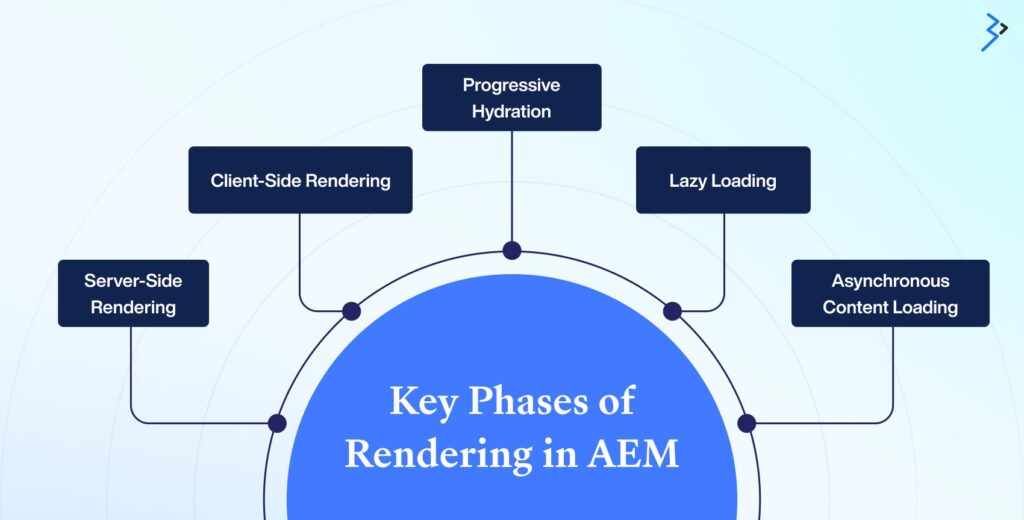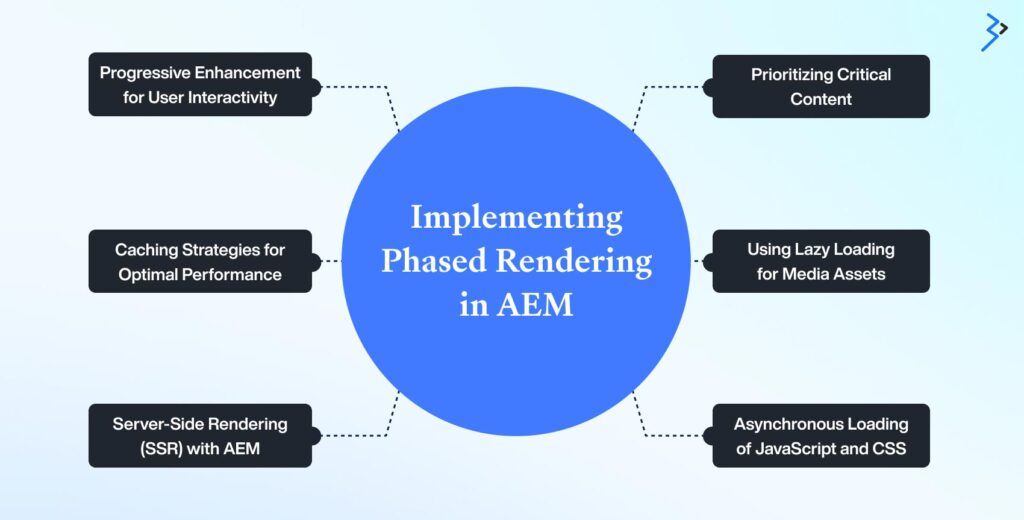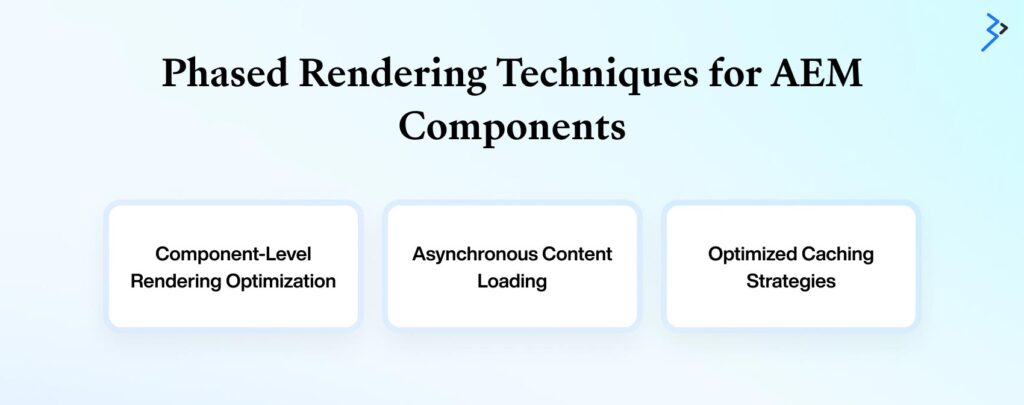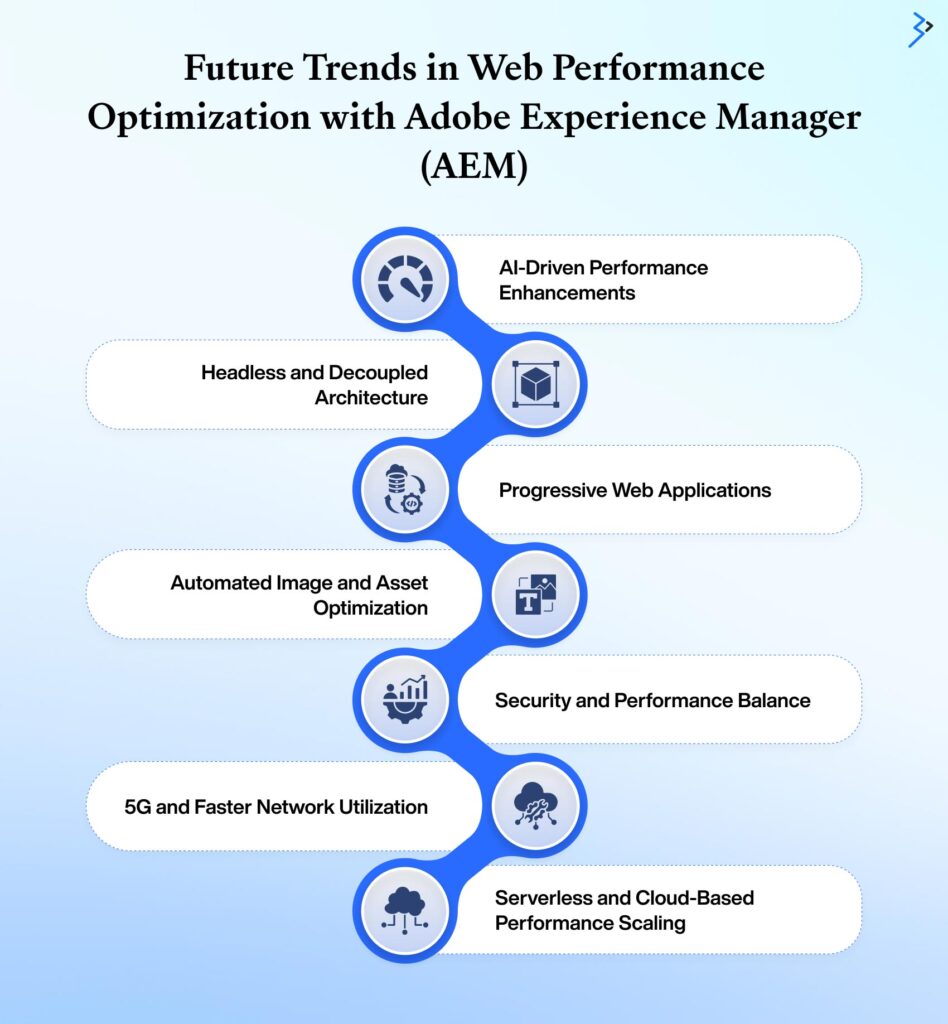Web speed is critical to maintaining an excellent user experience, search engine rankings, and conversion rates. Phased rendering in Adobe Experience Manager (AEM) is a great way to improve online speed.
Phased rendering allows quicker page loads by prioritizing vital material first and gradually loading other pieces. This strategy minimizes perceived latency while improving performance, particularly for complicated online applications.
Therefore, this blog looks at the different aspects of optimizing web performance with phased rendering in AEM. Let’s get started!
Understanding Phased Rendering in AEM
Phased rendering is a method that allows some aspects of a webpage to load sequentially rather than all at once. Instead of waiting for the complete page to load before showing information, phased rendering prioritizes above-the-fold items and defers less critical components.
In AEM, phased rendering may be achieved by lazy loading, server-side rendering improvements, and client-side upgrades. Developers can use AEM’s robust architecture to enhance page performance and drastically minimize bounce rates.
Read More-: Elevate your Adobe Experience Manager Sites Website with Generative AI Chatbots
Benefits of Phased Rendering

- Improved Page Load Speed: Emphasizing above-the-fold material helps consumers perceive a speedier experience, which reduces irritation and increases engagement.
- Enhanced SEO Performance: Search engines like faster-loading pages, which can boost ranks and organic visitors.
- Optimized Resource Utilization: Efficiently loading resources in stages avoids server overload and optimizes bandwidth utilization.
- Better User Experience: Users can interact with visible material while other pieces are still loading in the background.
- Reduced Bounce Rates: Users are less likely to leave a site if the pages load faster.
Key Phases of Rendering in AEM

1. Server-Side Rendering (SSR)
Server-side rendering guarantees that key material, including hero sections and navigation bars, is preloaded before it is delivered to the client. This method considerably improves the first page load time.
2. Client-Side Rendering (CSR)
Following SSR, dynamic components such as interactive forms and animations are rendered on the client side. This strategy reduces server load while increasing website responsiveness.

3. Progressive Hydration
Rather than displaying all JavaScript-heavy elements simultaneously, AEM supports progressive hydration, which loads interactive components sequentially. This strategy enables seamless transitions and avoids performance bottlenecks.
4. Lazy Loading
Lazy loading delays the loading of non-critical resources, such as photos and movies, until they are needed. This reduces the initial load time and conserves bandwidth.
5. Asynchronous Content Loading
Asynchronous loading guarantees that supplementary scripts and widgets are retrieved concurrently without interfering with significant content, decreasing latency, and increasing user experience.
Read More-: Why Does Adobe Experience Manager Matter – Accelerating the Journey from Content to Experience
Implementing Phased Rendering in AEM

1. Prioritizing Critical Content
The first step in phased rendering is identifying and prioritizing vital material to be loaded initially. This includes:
- Page headings, navigation menus, and hero images
- Primary call-to-action buttons
- Key text and important media components
AEM enables developers to alter templates and components so that these elements load quickly while secondary information is deferred.
2. Using Lazy Loading for Media Assets
Lazy loading is a popular phased rendering approach that delays loading pictures and videos until required. This decreases the first page load time and enhances performance.
- To implement in AEM, use the loading=”lazy” tag on images in components.
- Use AEM’s built-in image presets to optimize pictures dynamically based on the user’s device.
3. Asynchronous Loading of JavaScript and CSS
Loading JavaScript and CSS files asynchronously ensures that render-blocking resources do not delay content presentation.
AEM best practices include
- Using the defer or async properties for JavaScript scripts.
- Reduce HTTP requests by minimizing and bundling CSS files.
- Use AEM ClientLibs to handle dependencies efficiently.
Read More -: What is the Navigation in Adobe Experience Manager
4. Server-Side Rendering (SSR) with AEM
AEM includes powerful server-side rendering (SSR) features that pre-render pages before providing them to users. This guarantees that key material is readily accessible, which improves perceived performance.
Key techniques:
- Use AEM Sling Models to create JSON-based server-side replies.
- Pre-render commonly visited material and cached responses to ensure quicker delivery.
5. Caching Strategies for Optimal Performance
Caching is essential for phased rendering since it stores pre-computed replies and reduces server load. AEM supports a variety of caching techniques, including:
- Dispatcher Caching: Caches static and dynamic material on the CDN level.
- Browser Caching: Uses Cache-Control headers to direct browsers to save assets locally.
- Edge Caching: This implements edge caching to minimize latency for worldwide users.
6. Progressive Enhancement for User Interactivity
Progressive enhancement guarantees a webpage is usable before all scripts and styles are loaded. Key strategies include:
- Providing alternative content for browsers that do not support JavaScript.
- The fundamental functionalities are implemented using lightweight HTML and CSS.
- Once all scripts have loaded, the interaction will be enhanced dynamically.
Phased Rendering Techniques for AEM Components

1. Component-Level Rendering Optimization
AEM components should be organized so that phased rendering works efficiently. Techniques for optimization:
- Divide components into smaller, reusable bits that can load independently.
- For a more streamlined visual experience, use skeleton displays rather than spinners.
- Preload crucial CSS and skip non-essential style sheets.
2. Asynchronous Content Loading
Instead of rendering all content synchronously, AEM allows dynamic components to load asynchronously.
Implementation Steps:
- Use AEM Sling Models Exporter to provide JSON data asynchronously.
- Implement GraphQL queries to get only the required material on demand.
- Use AEM Content Fragments API to send structured data.
3. Optimized Caching Strategies
Proper caching strategies decrease the burden on AEM servers and speed up content delivery.
Best practices:
- Use browser caching for static files such as CSS and JavaScript.
- Use AEM Dispatcher Caching to save frequently requested pages.
- Use service workers for offline content caching.
Read More-: Integrating Adobe Commerce Cloud with Adobe Experience Manager
Future Trends in Web Performance Optimization with Adobe Experience Manager (AEM)

As digital experiences grow, boosting web speed has become a top issue for organizations utilizing Adobe Experience Manager Services. Faster website load speeds, consistent user experiences, and compelling content distribution are critical for engagement and conversions.
Here are some essential future developments influencing web performance improvement in AEM.
AI-Driven Performance Enhancements
Artificial intelligence (AI) is automating many procedures to improve web speed in AEM. AI-powered systems may evaluate user behavior, identify performance bottlenecks, and recommend real-time improvements. Machine learning algorithms also aid in dynamic content loading, ensuring consumers view the most relevant information rapidly. Additionally, AI can help with anticipatory caching, decreasing server load, and improving response times.
Edge Computing and CDN Advancements
Content Delivery Networks (CDNs) are emerging with edge computing to reduce latency and improve AEM performance. Edge computing improves page performance by processing requests closer to the end user. Modern CDNs also include AI-driven caching methods and real-time traffic routing, resulting in considerable speed improvements.
Headless and Decoupled Architecture
The transition to headless CMS in AEM is gaining traction as organizations strive for multichannel digital experiences. A headless configuration sends content via APIs to multiple front-end apps, minimizing needless rendering delays. Organizations may improve cross-device performance by separating the back-end and front-end.
Progressive Web Applications (PWAs)
Progressive Web Applications (PWAs) transform how users engage with web applications. AEM’s integration with PWAs enables web pages to load rapidly, especially in low-network environments. Thanks to effective caching by service workers, PWAs deliver an app-like experience with better performance and engagement, making them a future-proof option for web optimization.
Automated Image and Asset Optimization
Optimizing pictures and media assets is crucial for increasing performance. Future improvements in AEM will more heavily use AI-powered asset compression and adaptive picture delivery based on user device and bandwidth. Automated asset transformation, which includes next-generation picture formats such as WebP and AVIF, will help minimize load times while retaining visual quality.
Efficient Lazy Loading and Phased Rendering
Lazy loading, which delays the loading of non-critical resources, is already considered best practice. However, future AEM implementations will prioritize phased rendering approaches, loading crucial page components first. This guarantees that customers view relevant material immediately while the remainder loads smoothly in the background. Techniques like server-side rendering (SSR) and hybrid rendering models will considerably improve performance.
Real-Time Performance Monitoring and Adaptive Optimization
AEM will continue to have comprehensive real-time performance monitoring features. These tools give information on page load times, user interactions, and system bottlenecks. AEM’s adaptive performance optimization allows it to dynamically alter content delivery tactics based on user location, device kind, and network circumstances, resulting in a seamless experience.
Security and Performance Balance
As online security concerns increase, future web optimization in AEM will prioritize balancing performance and security. Techniques such as better encryption, secure HTTP/3 implementation, and bot detection systems will be critical in maintaining performance while protecting against cyberattacks.
5G and Faster Network Utilization
The emergence of 5G networks will fundamentally alter how AEM manages content delivery. Faster networks allow online assets to be heavier while still loading promptly. Future AEM enhancements will use 5G capabilities for ultra-fast content streaming, dynamic online experiences, and real-time customization without sacrificing performance.
Serverless and Cloud-Based Performance Scaling
The transition to serverless architectures in AEM will enable enterprises to scale resources flexibly depending on demand. Cloud-based performance scaling and auto-healing infrastructure will decrease downtime and provide consistent user experiences during peak traffic. Serverless computing significantly reduces backend processing, which improves response times and lowers operating expenses.
Conclusion
Phased rendering in Adobe Experience Manager is an effective strategy for improving web speed. Businesses may significantly improve user experience and SEO results by prioritizing vital information, using server and client-side rendering effectively, and following best practices such as lazy loading and caching.
A staged approach with a professional Adobe Experience Manager guarantees that websites are quick, responsive, and engaging for users across devices and network circumstances.
You can balance performance and functionality by constantly evaluating and optimizing your AEM installation, assuring long-term success in the digital space.
Related Articles
-
What is the Navigation in Adobe Experience Manager (AEM)?
Summary Delivering a seamless user experience is crucial for evolving businesses! Today, more than ever, customers are inclined towards the look and feel of a website before trusting the brand.
-
Integrate AEM with Salesforce: Your DIY Guide
Summary An organization is as successful as its software suite. Wonder why? Access to the best software allows organizations to streamline different aspects of their business and automate their workflow.
-
How Retail Businesses Use AEM for eCommerce and Customer Engagement
Summary: It’s 2024; your online business needs more than a working website to stand among your competitors. Besides, your ideal clients won’t waste time around slow-loading websites to complete their




